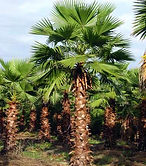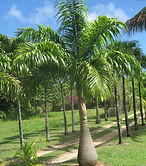The
Tree Store
Sourcing large trees for you...
Palm Trees & Cycads

Bismarck Palm / Bismark Palm (Bismarckia nobilis)
This Palm is found only in Madagascar. They grow on the plains of the central highlands, nearly reaching the western and northern coasts, in savannas of low grass, usually in lateritic soil. It grows from solitary trunks, gray to tan in color, which show ringed indentations from old leaf bases. Trunks are 30 to 45cm in diameter, slightly bulging at the base, and free of leaf bases in all but its youngest parts. They can grow up to 25m in natural habitat no taller than 12 m in cultivation. The nearly rounded leaves are over 3 m wide in maturity. Petioles are 2–3 m, slightly armed, and are covered in a white wax as well as cinnamon-colored caducous scales; the nearly-spherical leaf crown is 7.5m wide and 6m tall. Most cultivated Bismarckias feature silver-blue foliage although a green leaf variety exists (which is less hardy to cold). These palms are dioecious and produce pendent, inter foliar inflorescences of small brown flowers which, in female plants, mature to a brown ovoid drupe, each containing a single seed.

Cocos Palm / Kokos Palm (Syagrus romanzoffiana)
This is a palm native to South America, from northern Argentina north to eastern Brazil and west to eastern Bolivia. It is a medium-sized palm, quickly reaching maturity at a height of up to 15 m tall, with pinnate leaves. The Queen/Cocos Palm is found in most tropical and subtropical areas. It's very popular as an ornamental tree and much used in urban landscaping. However, the fronds die early and must be pruned to keep the tree visually pleasing. The fruits consist of a hard nut surrounded with a thin layer of fibrous flesh that is orange and sticky when ripe. The flavor is sweet and could be described as a mixture of plum and banana. They only need medium water and grow well in full sun.

Cycas Revoluta / Sago Palm (Cycas Revolutha)
It is Native to the southern Japan. It is one of the most widely cultivated cycads, grown outdoors in warm temperate and subtropical regions, or under glass in colder areas. It grows best in sandy, well-drained soil, preferably with some organic matter. It needs good drainage or it will rot. It is fairly drought-tolerant and grows well in full sun or outdoor shade, but needs bright light when grown indoors. This very symmetrical plant supports a crown of shiny, dark green leaves on a thick shaggy trunk that is typically about 20 cm in diameter, sometimes wider. The leaves are a deep semi-glossy green and about 50–150 cm long when the plants are of a reproductive age. They grow out into a feather-like rosette to 1 m in diameter. The petiole or stems of the sago cycad are 6–10 cm long with small protective barbs. As with other cycads, it is dioecious. It is widely used as an ornamental plant.

Fan Palm / Waaier Palm (Washingtonia robusta)
This Palm is native to the southwestern United States and northwest Mexico. They grow up to 25m tall. The fan Palm has leaves with a bare petiole up to 1m long terminating in a rounded fan of numerous leaflets up to 1m long. The flowers are in a dense inflorescence pale orange-pink, the fruits is spherical and edible, maturing into a small blackish-brown drupe 6–10 mm diameter with a thin layer of sweet flesh over the single seed. They are cultivated as ornamental trees. The species is also attempted in cooler climates, such as Vancouver Island, western Oregon and Washington state. You will find these trees as some kind of trademark along Waikoloa Beach Drive on the Big Island of Hawaii with snow-covered Mauna Kea in the background.

Lebombo Cycad / Lebomboe broodboom (Encephalartos lebomboensis)
It is Native to the Lebombo Mountains of South Africa. It has two separate populations, one in the vicinity of Mananga in Mpumalanga province in South Africa and a southern population centered on Piet Retief in the upper Pongola River Valley. It is a very rare and endangered species and grows in sunny positions on cliffs and steep, rocky slopes among sparse vegetation. This region has hot, fairly wet summers and cool, dry winters with frequent mists. It has a trunk that is up to 4m tall and 30cm thick; though the trunk is usually un-branched. The crown of the pinnate leaves is stiff, each having a mid to dark green glossy upper surface and paler under side. They are 100-150cm long and 20-27cm wide, straight or slightly arched, either flat or with a slight keel. Near the base of the leaves, the leaflets are reduced to prickles. This is a dioecious species. It is a popular species with plant collectors and listed as endangered because of its over-exploitation and the degradation of its habitat due to the encroachment of agricultural land.

Majesty or Shaving Palm Majesteit Palm (Ravenea)
The Majesty Palm is native to Madagascar and the Comoros. The extremely elegant, fast-growing majesty palm has upward-arching leaves that are divided into long, thin fingers. They have solitary robust grey stems, swollen at base and gradually tapering upward. The leaves are up to 2-5 m long, erect at first then arching, with numerous crowded narrow ribbed leaflets. The inflorescence is short, borne among the leaves; the fruit is a red drupe. It is an endangered species of flowering plant. It makes a fine conservatory feature plant, but make sure the roof is high enough, because, in the right conditions, it can get quite tall. Relatively easy to grow, it tolerates low light and cool conditions but needs decent summer humidity - a dry atmosphere can be fatal. Water the palm well over summer, but only when the surface of the potting mix dries, and add a liquid fertilizer every two weeks. Keep just moist in winter.

Natal Giant / Natalse broodboom (Encephalartos natalensis)
A South African endemic, the Natal giant cycad is widespread through southern Kwa-Zulu Natal, with outlying population in the Eastern Cape. Usually occurs on rocky coasts and outcrops inland from the coast. Although the wild population is still fairly large the Natal giant cycad is thought to be undergoing a slow decline due to habitat loss. It reaches a height up to 6m tall. For a long time cycads were thought, like cone-producing conifers, to be entirely wind pollinated. However, studies now suggest that the vast majority, if not all cycads, are actually pollinated by insects or more specifically weevils. To attract pollinators, male and female cones produce powerful odors, usually in the early morning or evening. The seeds produced by cycads are large and have a fleshy outer coat, but are relatively short-lived and vulnerable to dehydration.
***All images on this page illustrate a fully grown specimen and NOT the actual size we sell***